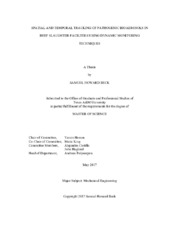| dc.description.abstract | Salmonella and Shiga toxin producing E. coli (STEC) have been recognized as pathogens of concern in meats due to the prevalence of this microorganism in the gastrointestinal tract and hide of livestock. Bacterial ingestion due to contaminated food products causes a great economic burden from the hospitalization and death of those who become infected. STEC and Salmonella annually cause an estimated 470 deaths in the United States alone. An estimated max of 77.1 billion dollars are lost each year as a direct result of contaminated food. During the harvesting process, these pathogens may become aerosolized from carcass by various mechanisms, including worker activity and airflow from heating, ventilation, and cooling (HVAC) systems.
In this study, one small rural facility and one medium-sized beef facility were examined. High air volume wetted wall cyclone (WWC) bioaerosol samplers capable of concentrating bioaerosols in a liquid effluent were used throughout processing at bleeding, de-limbing, de-hiding, washing, and other stages. Bioaerosols were analyzed using plating and qPCR techniques. Total bacteria count (TBC), STEC concentrations, and Salmonella concentrations were enumerated in the air, and critical areas were identified. Salmonella and STEC were found to increase with each passing day in the facility, and TBC and STEC increased between morning and afternoon phases of processing. Significant differences in TBC and temperature were found at different locations in the facilities. A novel unmanned aerial system (UAS) capable of capturing bioaerosols at high altitudes was testing alongside the WWC in cattle feedlots. The UAS performed well, capturing significant concentrations of STEC and TBC.
As of now, HVAC systems have not been studied in correlation with the movement and concentration of bioaerosols in slaughter facilities. Blueprints were obtained from the examined facilities, the cattle processing floors were modeled, and computational fluid dynamics (CFD) were performed. The airflow created from the HVAC systems was found to have an enormous effect on the spread of bioaerosols. Similarities were found between the collected concentrations of bioaerosols and particle traces in the modeled facilities. Finally, new HVAC models were generated for the facilities to significantly increase the sanitation of the beef slaughtering process. | en |


